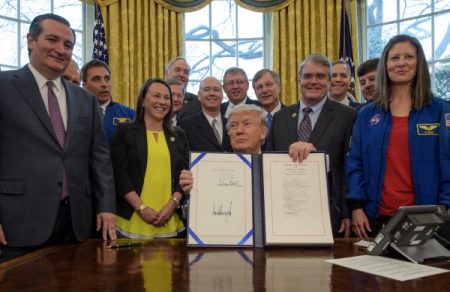March 3, 2018 – In 1969 NASA put humans on the Moon. In 1981 it launched the Space Shuttle. In 1998 NASA entered into a partnership with 16 countries and began assembling the International Space Station (ISS). Since these accomplishments, NASA’s human space project has entered a period subject to changing political objectives driven more by job-creating programs in various American states than by a single great mission like getting to the Moon.
First, there was President George W. Bush who in his administration directed NASA to plan a return to the Moon. Then President Barack Obama altered the objective to cis-lunar space with no planned return to the Moon’s surface. Instead, Obama directed NASA to develop Deep Space habitability and promoted a plan for NASA astronauts to go grab a near-Earth asteroid and bring it into lunar orbit for study. Under Obama, the American Space Shuttle program ended. NASA no longer could fly on American rockets to near-Earth space. It entered into a partnership with Roscosmos, the Russian space agency, paying for rides to the ISS. And that’s where NASA’s human space program stands today.
Enter President Donald Trump and his administration with its “America First” agenda. Would it revive NASA’s own capacity to fly to low-Earth orbit? Would it retain the objectives established by President Obama’s administration?
Needless to say, the answer to both questions has been “no.” And the cooperation with Roscosmos and NASA’s other international partners has been brought into question by a new set of Trump objectives. In recent months the Trump administration has announced mission objectives that include a return to the Moon and a future mission to Mars. Trump has increased NASA’s budget for human spaceflight.
While NASA’s human space program has drifted, it has taken Roscosmos and Russia along with it for the ride. The once ambitious Soviet effort to conquer space is today fairly subdued. Other state actors have entered the picture with China the third country to successfully launch human crews into near-Earth space. NASA has never taken steps to ally with China in creating a common human program for exploring space.
And in the absence of any direction within the American space agency, non-state actors have joined the space race. Companies like United Launch Alliance (ULA), a Boeing-Lockheed Martin partnership that has been a primary NASA contractor, SpaceX, Bigelow Aerospace, Blue Origin, and Sierra Nevada are now in the mix.
NASA continues to spend billions on a super-heavy rocket, the Space Launch System (SLS), which is a holdover from the George W. Bush era, sucking up billions of the agencies dollars in pursuit of getting to Mars sometime in the 2030s. NASA has abdicated it appears from its role in near-Earth space in pursuit of this Deep Space objective.
ULA has its own Atlas and Delta rockets and its own spaceship, the Starliner, for launching human crews to near-Earth orbit or even into Deep Space. Boeing and Lockheed have both indicated that they have plans to get to Mars with the latter building a permanent human presence in Martian orbit with shuttles to take crews to the planet surface for month-long expeditions.
SpaceX has built its own heavy payload launch capacity and a tried and true near-Earth launch capacity. It has the existing Dragon and near-finished Dragon 2.0 space capsules. It, today, can go to both near-Earth and Deep Space. It has plans to build a rocket to send colonists to Mars with a goal to create a permanent human presence there.
Bigelow Aerospace with its inflatable habitats is ready to put hotels and commercial space stations into near-Earth space. And it has plans to create lunar habitats based on its inflatable technology.
Blue Origin is building its own rockets for near-Earth and lunar space.
Sierra Nevada has a space-freighter and spaceplane designed for use in near-Earth space.
Meanwhile, NASA in the age of Trump is leaderless (it seems no one the President picks is qualified for the job) while attempting to figure out what to do with the ISS in the coming decade as the space station enters its fourth decade of use. The President wants to turn ISS over to commercial operators. The international partnerships appear to be ignored in the midst of this Trump brainstorming.
Even NASA’s non-human flight program is compromised by the lack of a permanent leader to provide a vision going forward. Trump has attacked NASA”s earth-science program because of his climate change stance. He can see a big picture but doesn’t sweat the details. For the agency, this lack of direction may lead to it being put out of business entirely.










